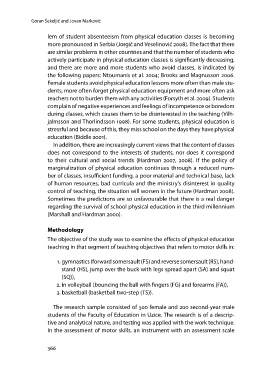Page 366 - Istenič Andreja, Gačnik Mateja, Horvat Barbara, Kukanja Gabrijelčič Mojca, Kiswarday Vanja Riccarda, Lebeničnik Maja, Mezgec Maja, Volk Marina. Ur. 2023. Vzgoja in izobraževanje med preteklostjo in prihodnostjo. Koper: Založba Univerze na Primorskem
P. 366
an Šekeljić and Jovan Marković
lem of student absenteeism from physical education classes is becoming
more pronounced in Serbia (Jorgić and Veselinović 2008). The fact that there
are similar problems in other countries and that the number of students who
actively participate in physical education classes is significantly decreasing,
and there are more and more students who avoid classes, is indicated by
the following papers: Ntoumanis et al. 2004; Brooks and Magnusson 2006.
Female students avoid physical education lessons more often than male stu-
dents, more often forget physical education equipment and more often ask
teachers not to burden them with any activities (Forsyth et al. 2009). Students
complain of negative experiences and feelings of incompetence or boredom
during classes, which causes them to be disinterested in the teaching (Vilh-
jalmsson and Thorlindsson 1998). For some students, physical education is
stressful and because of this, they miss school on the days they have physical
education (Biddle 2001).
In addition, there are increasingly current views that the content of classes
does not correspond to the interests of students, nor does it correspond
to their cultural and social trends (Hardman 2007, 2008). If the policy of
marginalization of physical education continues through a reduced num-
ber of classes, insufficient funding, a poor material and technical base, lack
of human resources, bad curricula and the ministry’s disinterest in quality
control of teaching, the situation will worsen in the future (Hardman 2008).
Sometimes the predictions are so unfavourable that there is a real danger
regarding the survival of school physical education in the third millennium
(Marshall and Hardman 2000).
Methodology
The objective of the study was to examine the effects of physical education
teaching in that segment of teaching objectives that refers to motor skills in:
1. gymnastics (forward somersault (FS) and reverse somersault (RS), hand-
stand (HS), jump over the buck with legs spread apart (SA) and squat
(SQ)),
2. in volleyball (bouncing the ball with fingers (FG) and forearms (FA)),
3. basketball (basketball two-step (TS)).
The research sample consisted of 500 female and 200 second-year male
students of the Faculty of Education in Uzice. The research is of a descrip-
tive and analytical nature, and testing was applied with the work technique.
In the assessment of motor skills, an instrument with an assessment scale
366
lem of student absenteeism from physical education classes is becoming
more pronounced in Serbia (Jorgić and Veselinović 2008). The fact that there
are similar problems in other countries and that the number of students who
actively participate in physical education classes is significantly decreasing,
and there are more and more students who avoid classes, is indicated by
the following papers: Ntoumanis et al. 2004; Brooks and Magnusson 2006.
Female students avoid physical education lessons more often than male stu-
dents, more often forget physical education equipment and more often ask
teachers not to burden them with any activities (Forsyth et al. 2009). Students
complain of negative experiences and feelings of incompetence or boredom
during classes, which causes them to be disinterested in the teaching (Vilh-
jalmsson and Thorlindsson 1998). For some students, physical education is
stressful and because of this, they miss school on the days they have physical
education (Biddle 2001).
In addition, there are increasingly current views that the content of classes
does not correspond to the interests of students, nor does it correspond
to their cultural and social trends (Hardman 2007, 2008). If the policy of
marginalization of physical education continues through a reduced num-
ber of classes, insufficient funding, a poor material and technical base, lack
of human resources, bad curricula and the ministry’s disinterest in quality
control of teaching, the situation will worsen in the future (Hardman 2008).
Sometimes the predictions are so unfavourable that there is a real danger
regarding the survival of school physical education in the third millennium
(Marshall and Hardman 2000).
Methodology
The objective of the study was to examine the effects of physical education
teaching in that segment of teaching objectives that refers to motor skills in:
1. gymnastics (forward somersault (FS) and reverse somersault (RS), hand-
stand (HS), jump over the buck with legs spread apart (SA) and squat
(SQ)),
2. in volleyball (bouncing the ball with fingers (FG) and forearms (FA)),
3. basketball (basketball two-step (TS)).
The research sample consisted of 500 female and 200 second-year male
students of the Faculty of Education in Uzice. The research is of a descrip-
tive and analytical nature, and testing was applied with the work technique.
In the assessment of motor skills, an instrument with an assessment scale
366


